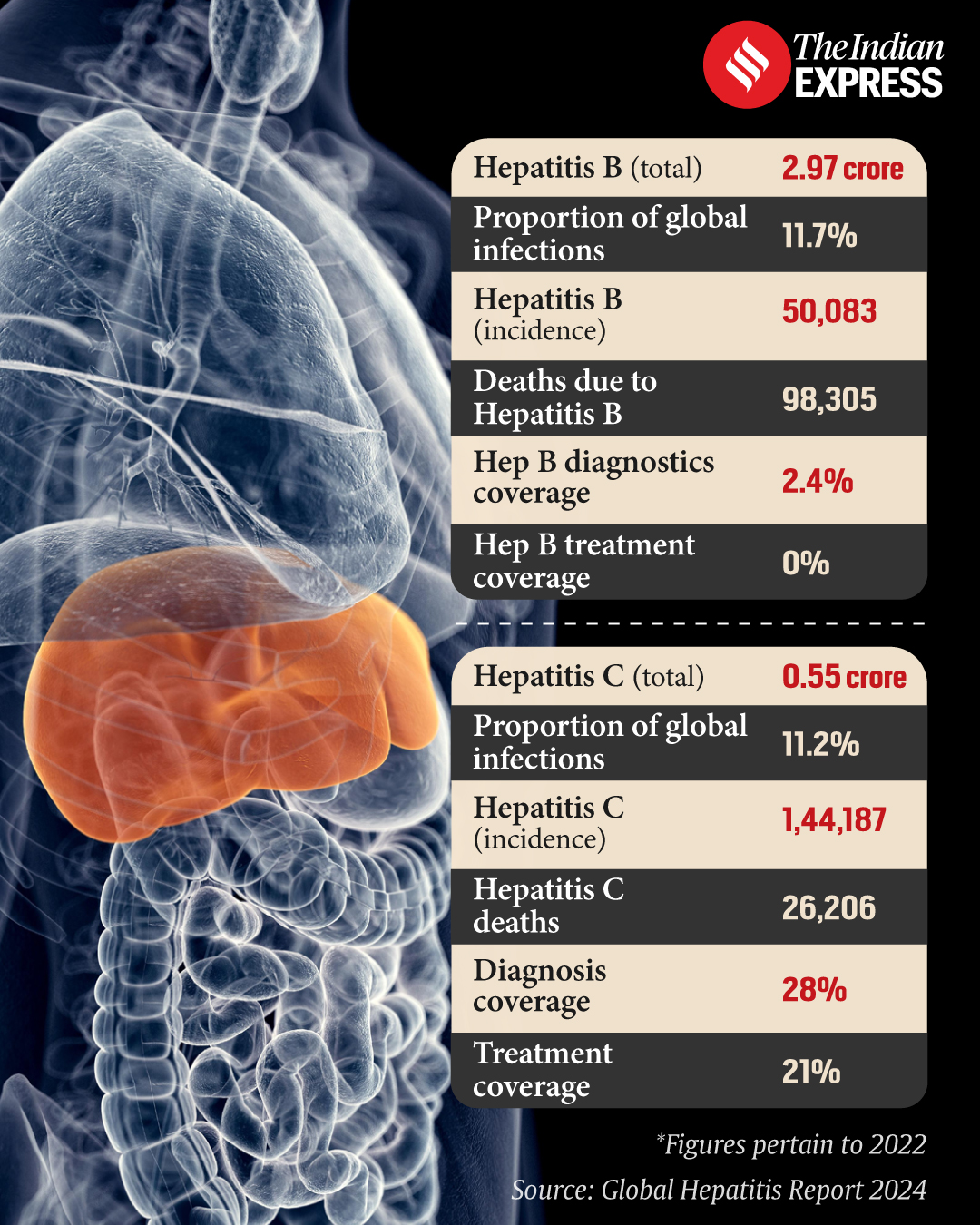India is one of the countries with the highest burden of viral hepatitis — an infection that causes liver inflammation, damage and may lead to liver cancer — with 2.9 crore people living with Hepatitis B infection and 0.55 crore living with Hepatitis C infection, according to the Global Hepatitis Report 2024 released by the World Health Organisation (WHO) on Tuesday.
There were over 50,000 new Hepatitis B cases and 1.4 lakh new Hepatitis C cases reported in 2022. And these infections killed 1.23 lakh people in India in 2022 as per the report. Both infections are transmitted from mother to child during delivery, during transfusion of blood that hasn’t been screened properly, during contact with the blood of an infected person or while sharing of needles by drug users. Since hepatitis B can be prevented through vaccination, the report highlights the need to ensure coverage. Hepatitis C is curable with medicines.
“In order to reduce the burden of Hepatitis B in India, there is a need to ensure that all newborns receive complete vaccination. It should also be offered to adults who were born before the vaccine was included in the national programme,” says Dr SK Sarin, vice-chancellor of the Delhi-based Institute of Liver and Biliary Sciences.
WHAT ARE HEPATITIS B AND C?
Hepatitis B is known to cause acute infection with nausea, vomitting and yellowing of the eye and skin for several weeks. Liver failure happens in severe cases. But the challenge is the chronic, life-long liver disease that it causes, especially when children get it. The chronic infection can lead to scarring of the liver called cirrhosis and increase the risk of liver cancer. There are medicines to slow the progress of the virus in chronic cases.
Many people with the hepatitis C virus don’t have symptoms or know they are infected. Those who do develop symptoms two to 12 weeks after exposure report yellow skin or eyes, loss of appetite, nausea, stomach ache, fever, dark urine, light-coloured stool, joint pain and exhaustion.
Globally, with nearly 1.3 million deaths a year, viral hepatitis kills as many people as tuberculosis. Both remained the second biggest infectious killer in 2022, behind only the deaths caused by the Covid-19 pandemic. There are around 304 million people living with Hepatitis B and C across the world as per the report.
NEED TO EXPAND DIAGNOSTICS AND TREATMENT
In India, while the numbers of deaths due to viral hepatitis aren’t comparable to tuberculosis — TB killed an estimated 3.31 lakh people in 2022 — what is concerning is that the coverage of diagnosis and treatment for the infections remains very low. The report says that only 2.4 per cent of the Hepatitis B cases were diagnosed and 0 per cent received treatment. For Hepatitis C, the coverage of diagnostics and treatment was found to be better in India, with 28 per cent being diagnosed and 21 per cent receiving treatment.

The coverage remains poor despite the fact that several Indian companies manufacture generic versions of the drugs as well as diagnostics. In fact, the cost of treatment with different combinations of drugs in India remains one of the lowest, as per the report. “Although there’s a national viral hepatitis control programme — and ILBS was one of the driving forces behind it — its reach is limited. People have not been utilising the free diagnostics and treatment offered under the programme,” says Dr Sarin.
WHAT EXPLAINS THE INFECTION SPIRAL?
Hepatitis B infections in the country, he explains, are mainly being driven by transmission from mother to child. “Almost 90 per cent of Hepatitis B transmission happens from the mother to the child because all the blood banks in India are now providing safe blood. Needle-stick transmission in healthcare workers is also limited because most are vaccinated,” he adds.
Hepatitis B vaccine is offered to children under the Universal Immunisation Programme in India. The government’s viral hepatitis control programme also offers the vaccine to high-risk adults such as healthcare workers as well. Treatment for both Hepatitis B and C is available under the programme.
“It is important to treat everybody. Currently, Hepatitis B is treated by specialists as per guidelines. And even among those who have been diagnosed, eight of ten people remain ineligible to receive treatment as per guidelines. There is a need to offer treatment to all those who have been diagnosed, just as we do for HIV because it will reduce the health consequences for them,” says Dr Sarin.
When it comes to Hepatitis C, the availability of short-duration treatment is half the battle won. Unlike Hepatitis B, where the drugs have to be taken for life, the treatment for Hepatitis C lasts for 12 to 24 weeks. “This cures 80 to 90 per cent of patients,” says Dr Sarin. The need now is to ensure that people are diagnosed and treated at the earliest.
© The Indian Express Pvt Ltd
First uploaded on: 09-04-2024 at 20:01 IST







